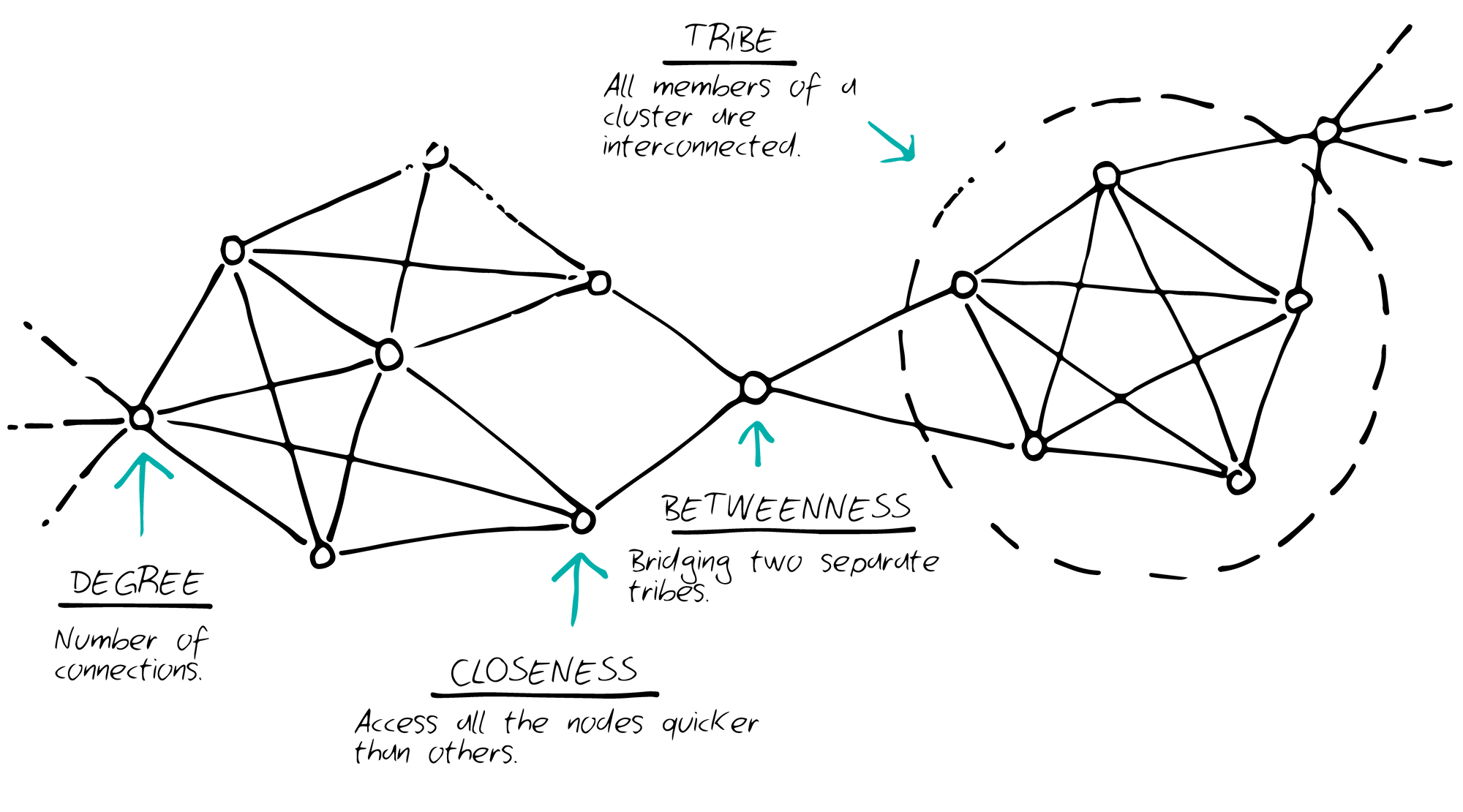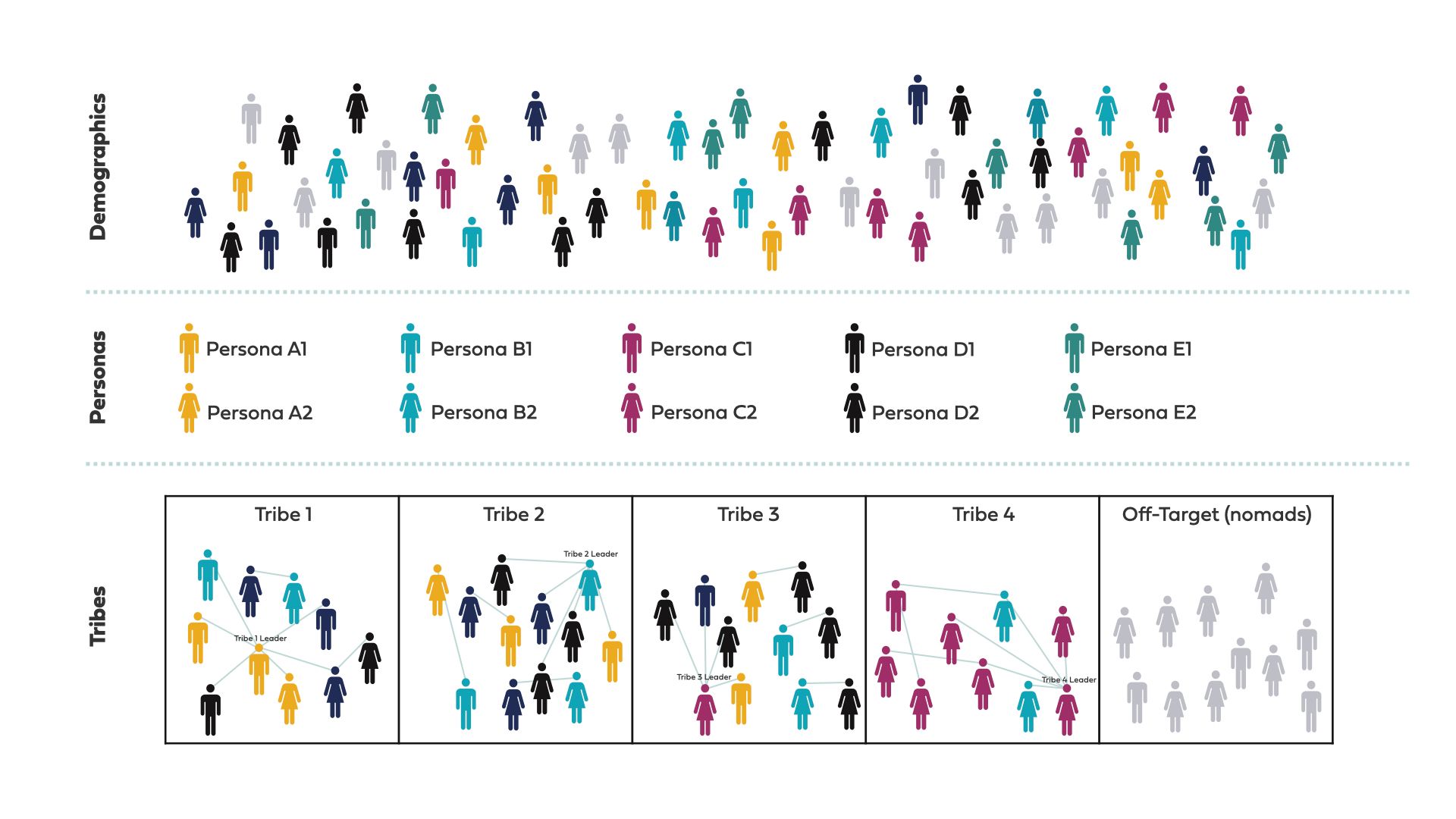What are consumer tribes?
"Consumer tribes (Cova et al. 2007) are naturally occurring groups where tribe members identify with one another (or they can be ‘activated’ and encouraged to be linked by social media or marketing activities). They have shared experiences and emotions. They can engage in collective, though ephemeral, social action – that is, as members of the tribe, consumers can ‘do’ things that they would not be able to do as non-members. A consumer tribe could form around any leisure-based activity, interest, hobby, or passion. As Cova and Shankar (2012: 180) stated, ‘if you are passionate about surfing, traveling, a TV show, snowboarding, running, reading books, a band or singer, knitting, fine wine, a film-star, music, international politics, fossil-hunting, or fishing, the rise of social media … means that you can search for and find other likeminded devotees and voilà you will have the basis of a tribe’."
Arnould, E., & Thompson, C. J. (2018)

Our methodology for finding and analyzing consumer tribes
The study of sociograms is used to give visibility and understand the consumer tribes that follow or interact with profiles or pages of commercial brands, groups, or marketing campaigns in different social media.
First, the sociometric study allows "taking an X-ray" of any cybernetic framework. The result of this visualization is a sociogram that presents follow relationships (I follow you/you follow me/we follow each other) on Twitter, relationships of users that interact with content and/or check-in (interaction/posts/check-ins) on Facebook, Instagram, and TikTok.
Follow and co-interaction relations are analyzed instead of conversations, hashtags or texts (Social Media Listening) to understand how a digital community is structured more precisely, not only importing the relationship that a user has with the followed account (which s analyzed) but also revealing the social graph of that same user (the followers of the follower) in relation to said convergence account.
The analysis of conversations captures only a fleeting moment in which users addressed a particular topic (always publicly), questioning the degree of commitment in the medium and long term regarding said topic. In contrast, analyzing the relations of those who have "followed" an account or interacted with its contents adds a greater degree of commitment or interest regarding the discourse and publications that said account represents and propagates.
In the sociogram, the nodes represent the users and the edges express the follow relationships or interactions between them. Now, these maps are clustered in colors by the reciprocal number of edges between a group of profiles; each color indicates a group of highly connected profiles, which translates to identifying a consumer tribe. Finally, the size of the nodes represents the number of connections generated by a user: a profile with a considerable number of connections appears larger, and vice versa; a profile with few connections acquires a smaller size.

It is worth mentioning that two key concepts to understand sociograms are: a) digital tribe and b) digital public places (DPP) (González and Servin, 2017). The digital tribe refers to a group of people who are physically united and share practices and customs that give them a symbolic sense of belonging. In fact, they do not need physical space to consolidate; thus, they arise from shared digital experiences (Cova & Cova, 2002). The digital public place is the non-physical reticular "floor" that facilitates the union between users. With this approach, we interpret the commercial accounts or pages in social media as digital public places since they are not only profiles or hyperlinks but also a digital space in which human relationships are formed that can be approached from social and computer sciences.

Segmentation
Segmentation is the process of grouping a population into clusters, or segments, that have common attitudes and needs so we can more efficiently market to them.
An effective segmentation will enable us to tailor specific products and services to our target segments, driven by a deep analysis of their cultures, self-representation, and approach to a given market. It will also guide our strategy for marketing and communications.
Our proprietary technology allows us to pull data based on how users interact with content from social media channels, for example, likes from posts on a Facebook Page. The result is that users segment themselves based on their common affinities and corresponding interactions; we just made them visible through social network analysis techniques.
Frequently Asked Questions
How do you find the tribes displayed on this platform?
Behind each digital tribe file is a sociogram analysis carried out by Antropomedia's researchers. This means that the information presented comes from actual research carried out for our different clients.
Which is the consumer tribe's lifespan?
Maffesoli asserts (1996 [1988]: 140) that "The tribes have varied lifespans according to the degree of investment of the protagonists."
Is there a difference between digital tribes and consumer tribes?
The term "digital tribe" only refers to a consumer tribe engaging in socialization and consumption through digital technologies, platforms, and social media.
Which are the differences between User or buyer personas and consumer tribes?
User or Buyer Personas:
- User or Buyer Personas are static -individual- representations of potential users or customers.
- They help align product development efforts, user-intended success stories, and UX/UI best-case scenarios.
- It isn’t easy to estimate a segment or market size relying on User or Buyer Personas.
- It is difficult to monitor how much of the Buyer or User Personas respond to communication campaigns, mostly because companies cannot observe their reaction to marketing campaigns.
- The term “Persona” represents an individual person, which carries a lot of subjectivity.
- Discovering new User or Buyer Personas can eventually become customers is hard.
Consumer Tribes: - They are dynamic -collective- descriptions of how real users interact with specific media stimuli.
- Tribes gather around strong passions like F1, Japanese manga, or The Mandalorian. These factors are independent of their demographic data.
- This type of segmentation is dynamic and flexible enough to capture changes in patterns of people’s lives and priorities.
- They’re grounded on Big Data (scale) but with the human context given by social sciences (depth).
- Tribes acquisition, and response to marketing campaigns, can be easily tracked, measured, and monitored because of their quantifiable social media data origin. Antropomedia can know how many users who interacted with a specific Social Media Campaign belong -or not- to which tribe.
- Tribes segmentation metadata (other brands they follow, location, tribe leaders -influencers- they connect with, etc.) helps direct advertising efforts.
- Tribal segmentation regards consumption from a social and cultural point of view rather than more narrowly as an economic exchange.
- It’s easy to discover new tribes that can eventually become customers. This is possible because Antropomedia can dig into competitors’ digital communities to find them out.

References
• Arnould, E., & Thompson, C. J. (2018). Consumer Culture Theory (1st ed.). SAGE Publications Ltd.
• Burlacu, M. (2014). Digital Anthropology: Theoretical Perspectives regarding Electronic Tribes. Bulletin of the Transilvania University of Braşov, Series VII: Social Sciences and Law, 1, 241–248.
• Cova, B., & Cova, V. (2002). Tribal marketing. European Journal of Marketing. https://www.emerald.com/insight/content/doi/10.1108/03090560210423023/full/html
• de Grande, P. (2013, May). Aportes de Norbert Elias, Erving Goffman y Pierre Bourdieu al estudio de las redes personales. Andamios. http://www.scielo.org.mx/scielo.php?script=sci_arttext&pid=S1870-00632013000200013
• González, L. J., & Servin Arroyo, A. (2017). Métodos cualitativos digitales. Virtualis. https://www.revistavirtualis.mx/index.php/virtualis/article/view/220/202
• Kozinets, R. V. (2015). Netnography: Redefined (2nd ed.). SAGE Publications.
• Leetoy, S., & Servin Arroyo, A. (2018). Personalización de la política en tiempos de wikis: tribus digitales en Twitter en torno a la candidatura ciudadana de Pedro Kumamoto. In Ciudadanía digital y democracia participativa (pp. 201–228). Comunicación Social.
• Lillqvist, E., Moisander, J. K., & Fuat, A. (2017, October). Consumers as legitimating agents: How consumer-citizens challenge marketer legitimacy on social media. International Journal of Consumer Studies, 197–204.
• Mamali, E., Nuttall, P., & Shankar, A. (2018). Formalizing consumer tribes: Towards a theorization of consumer-constructed organizations. Marketing Theory, 1–22.
• O’Reilly, D. (2012). Maffesoli and consumer tribes : developing the theoretical links. Marketing Theory. https://journals.sagepub.com/doi/10.1177/1470593112451801
• PSFK. (2020). What’s Next: Generation Anti-Identity. Complex Networks & PSFK. https://www.psfk.com/report/whats-next-generation-antiidentity-moving-beyond-demographics-complex-report
• Servin, A. (2022, June 1). The Construction of Collective Identities in Social Networks. Global Digital Humanities Symposium Proceedings. https://msuglobaldh.hcommons.org/2022/06/01/the-construction-of-collective-identities-in-social-networks/
• Schäfer, M. T., & van Es, K. (2017). The Datafied Society: Studying Culture Through Data. Amsterdam University Press English.
• Somoza, V., Giacalone, D., & Chester, R. (2017). Digital anthropology as method for lead user identification from unstructured big data. Creativity and Innovation Management. https://onlinelibrary.wiley.com/doi/abs/10.1111/caim.12228
• Sunderland, P. L., & Denny, R. M. (2007). Doing Anthropology in Consumer Research. Left Coast Press.
• Thompson, C. J. (2019). The “Big Data” Myth and the Pitfalls of “Thick Data” Opportunism: On the Need for a Different Ontology of Markets and Consumption. Journal of Marketing Management.
• Wang, T. (2017, January 3). Social identity dimensions and consumer behavior in social media. Asia Pacific Management Review, 22, 45–51.

